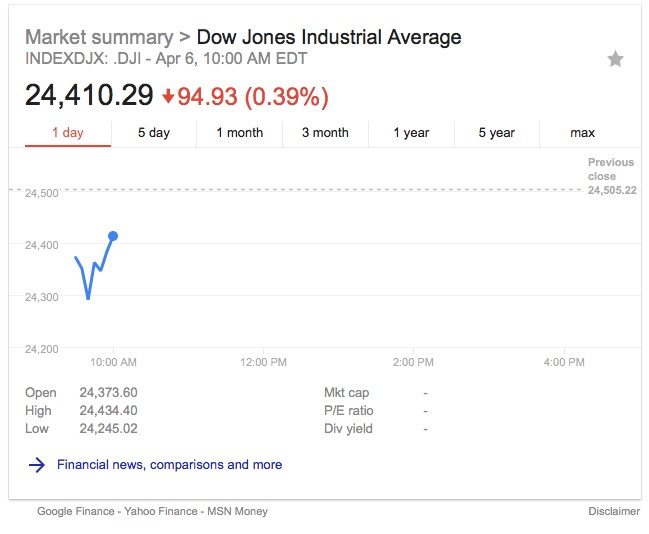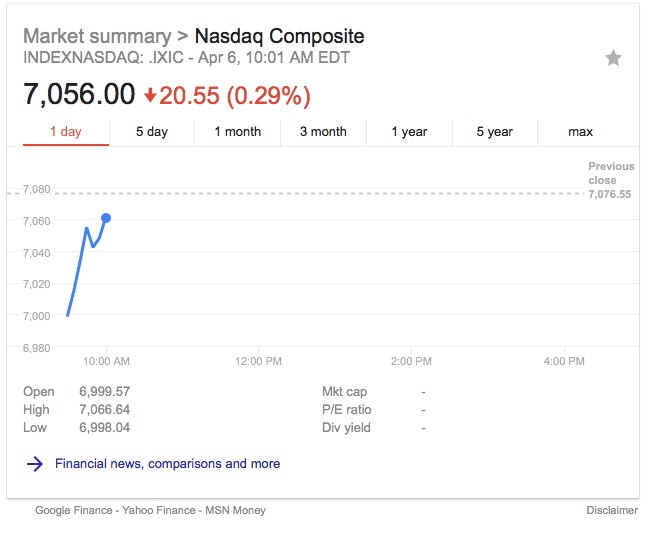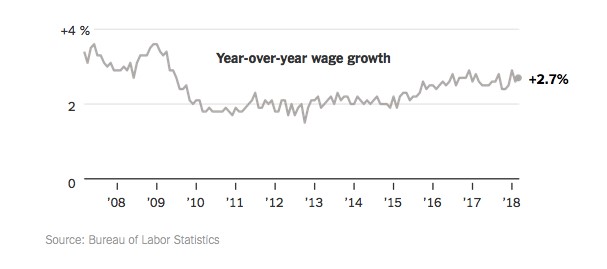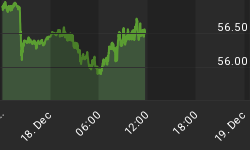A weak jobs report and the market’s inability to decide whether it fears a full-blown trade war or not amid Trump’s talk of slapping another $100 billion in tariffs on China saw the market take another dive after seeing its first three-day gain in a month on Thursday.
Late on Thursday, Trump escalated the pre-trade war atmosphere by directing U.S. trade officials to identify tariffs on more Chinese imports for an additional $100 billion.
The market, which just a day prior to this had decided that the trade war wasn’t real and that all the threats being bandied about were only proposals, not actual policies, switched sentiment again.
But this time, it wasn’t the only thing bringing down the market: A disappointing jobs report that has investors speculating that the Fed might, after all, shoot for four rate hikes this year.
By 10:00am EST, the Dow had lost over 94 points:

(Click to enlarge)
And the NASDAQ Composite was down over 20 points:

(Click to enlarge)
As the trade war preliminaries heat up, Trump’s new call for another $100 billion in tariffs targeting Chinese products is--in the president’s own words--punishment for “unfair retaliation” from the Chinese, which slapped import duties on over 120 U.S. products earlier this week.
While Trump recognized that the tariffs may cause “a little pain” for the U.S., he said that the trade war had been lost long ago and Americans would be better off in the long run with his new, aggressive stance.
In a Twitter message on Wednesday, Trump said: “That war was lost many years ago by the foolish, or incompetent, people who represented the U.S.”
Though earlier this week, the market had largely decided this was all bluster and trade war fears were overblown, speculators generally act first and interpret later. The result: U.S. equity futures saw another big sell-off after hours Thursday.
Related: The Most Common Market Manipulation Techniques
But trade war fears appear to be secondary when investors consider U.S. economic data and the specter more interest rate hikes from the Fed starts to loom larger.
The weak jobs report early on Friday would have pulled the market down, with or without toxic trade talk.
Jobs data for March shows that 103,000 jobs were added to the U.S. economy, representing the smallest gain in six months, with unemployment holding steady and some upward pressure on wages, while wage growth in February had slowed from January.

(Click to enlarge)
And right now, we’re looking at 90 straight months of job growth—a record streak.

(Click to enlarge)
Higher wages will be a key indicator of whether the Fed feels a fourth rate hike is necessary, but some analysts caution against jumping the gun on this. In February, the Fed was targeting three rate hikes this year, and nothing is set in stone yet.
Faster wage growth makes investors fear inflation because it’s the inflation bogeyman that will prompt the Fed to go for a fourth rate hike.
Was the drag on the market justified on this data? That’s a point of contention. The Fed is widely expected to raise rates again in June, but Robert Dye, chief economist at Comerica told MarketWatch that the Fed “has plenty of time to ponder whether to do three or four moves by the end of the year.”
But the looming trade war figures into Fed equations, says Gregory Daco, chief U.S. economist at Oxford Economics: “The Fed might decide to adopt a more cautious stance if the administration follows through with threatened tariffs.”
By David Craggen for Safehaven.com
More Top Reads From Safehaven.com:
















